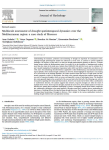Oubaha A., Ongoma V., Hssaine B.A., Bouchaou L., Chehbouni A. (2025). Multiscale assessment of drought spatiotemporal dynamics over the Mediterranean region: a case study of Morocco. Journal of Hydrology, 01/11/2025, vol. 661, part. C, p. 133723.
https://doi.org/10.1016/j.jhydrol.2025.133723
https://doi.org/10.1016/j.jhydrol.2025.133723
| Titre : | Multiscale assessment of drought spatiotemporal dynamics over the Mediterranean region: a case study of Morocco (2025) |
| Auteurs : | A. Oubaha ; V. Ongoma ; B.A. Hssaine ; L. Bouchaou ; A. Chehbouni |
| Type de document : | Article |
| Dans : | Journal of Hydrology (vol. 661, part. C, November 2025) |
| Article en page(s) : | p. 133723 |
| Langues : | Anglais |
| Langues du résumé : | Anglais |
| Catégories : |
Catégories principales 07 - ENVIRONNEMENT ; 7.5 - Dégradation : Impact, DésertificationThésaurus IAMM SECHERESSE ; ANALYSE SPATIALE ; CHANGEMENT CLIMATIQUE ; MAROC |
| Résumé : | Understanding the dynamics, prediction and monitoring of drought are important for anticipatory action. Although drought spatiotemporal analysis has advanced in recent years, it continues to present significant challenges. The objective of this study is to study the drought spatiotemporal dynamics in Morocco, a climate change hotspot within the Mediterranean region. Its novelty lies in the possibility of simultaneously tracking more than one cluster in the study area. Datasets from PERSIANN-CDR and ERA5 were used to calculate the 3 and 9-month Standardized Precipitation Evaporation Index (SPEI3 and SPEI9, respectively) over Morocco for 1983-2023. The methodology described herein is applicable to other Mediterranean, semi-arid and arid climate regions globally, where similar drought conditions are observed. Results highlight the importance of accounting for a second track in the tracking algorithm. The SPEI3 reported events that move at a high speed (228 km/ month) compared to SPEI9 (75 km/month). The SPEI9 event centroids indicated that northern regions experience mid to long-term droughts, which are severe and impactful in terms of hydrological stress. The identified dry events generally begin in the second half of the year and end in the first half of the following year, with no clear pattern regarding their initial and final locations. However, the tracks tend to follow either a northeastern or southwestern direction. The analysis suggests that extensive, long-term droughts are often the result of multiple shorter events. These long-term droughts, typically the most severe, show multiple peaks in severity and affected area, making their termination challenging to predict. Overlapping drought areas further complicates this. Additionally, similarities in the spatial patterns of drought events hint at common drivers, emphasizing the importance of studying different forcings that shape drought structures. The findings of this work open a window for impact-based monitoring of droughts in Morocco. This is helpful to the various stakeholders involved in building drought resilient water and agriculture systems. |
| Cote : | En ligne |
| URL / DOI : | https://doi.org/10.1016/j.jhydrol.2025.133723 |







